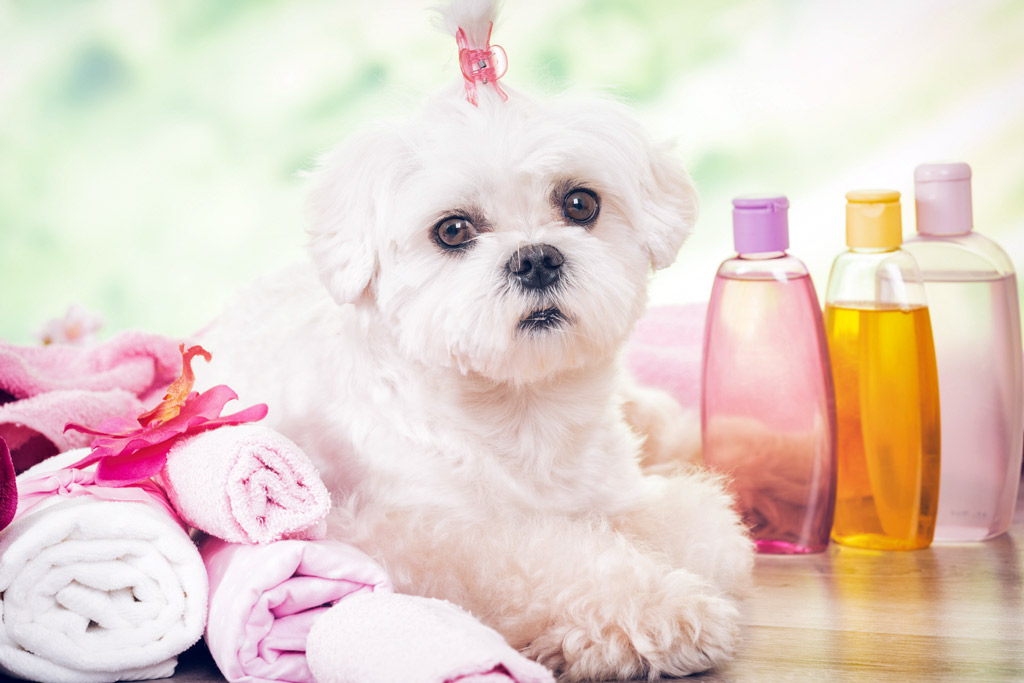
Grooming is part of taking care of your companion and it contributes to maintaining a healthy dog.
Being good for your dog doesn’t mean that she will like it. Some dogs are easy going and they let you brush them and bathe them without a fuss.
Others can get quite uncomfortable, so you will have to take it easy and do a bit at a time until they gradually tolerate you grooming them. And hopefully, they will like it enough in the future.
Insider Tip: The goal is to make grooming a positive, stress-free experience for both you and your pooch. Start small (i.e. short sessions) and try to restrain your doggy as little as possible. Also, reward your dog for staying calm with praise or high-value treats.
Grooming Tools
Before getting started… what do you need?
Dog Grooming Tools Checklist
These are the basic tools you will need if you are going to groom your doggy at home:
- A comb, brush or shedding blade (depending on your dog’s coat).
- Nail clippers or a grinder.
- Styptic powder (for nail bleed).
- Coat clipper (No. 10 blades to avoid cutting your dog’s skin).
- Grooming shears or scissors.
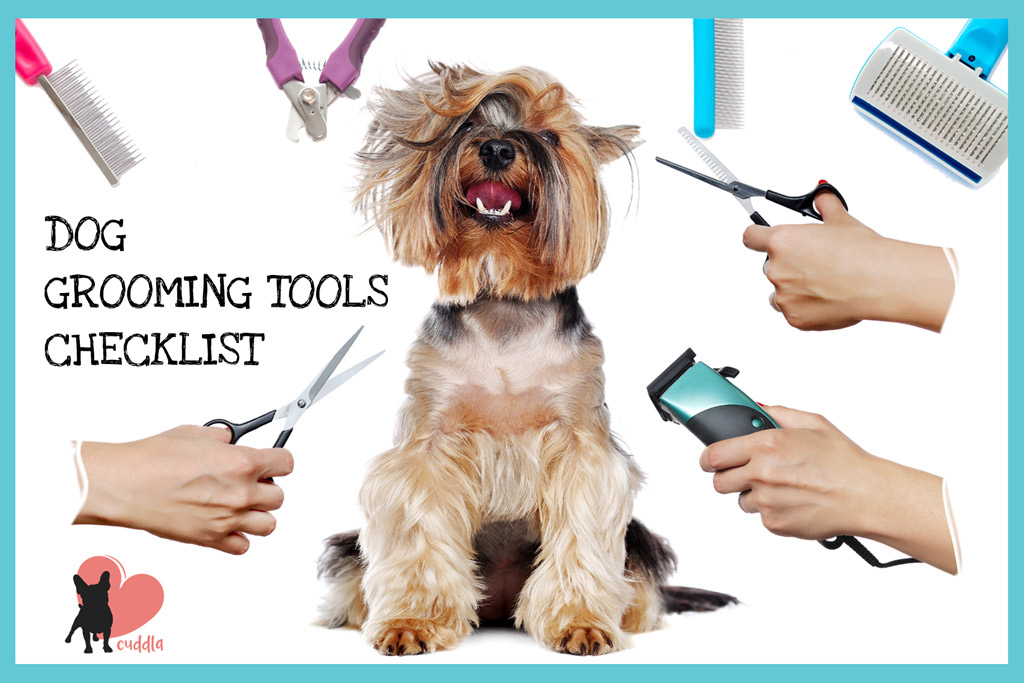
Grooming Tools for Bathing Your Dog
Here are the basics things you need to bath your dog at home:
- A bathing space: Kitchen sink, laundry tub, shop sink, walk-in shower or regular bathtub… or garden hose in warm weather.
- Towels: One for the tub, to reduce slipperiness and another to dry your dog with.
- A helper: Especially if your dog is nervous or new to this process.
- Cotton balls: To prevent getting water in the ears, and additional ones to clean the ears.
- Shampoo for dogs: (Refer to A Note on Dog Shampoos).
- A washcloth: For cleaning your dog’s face.
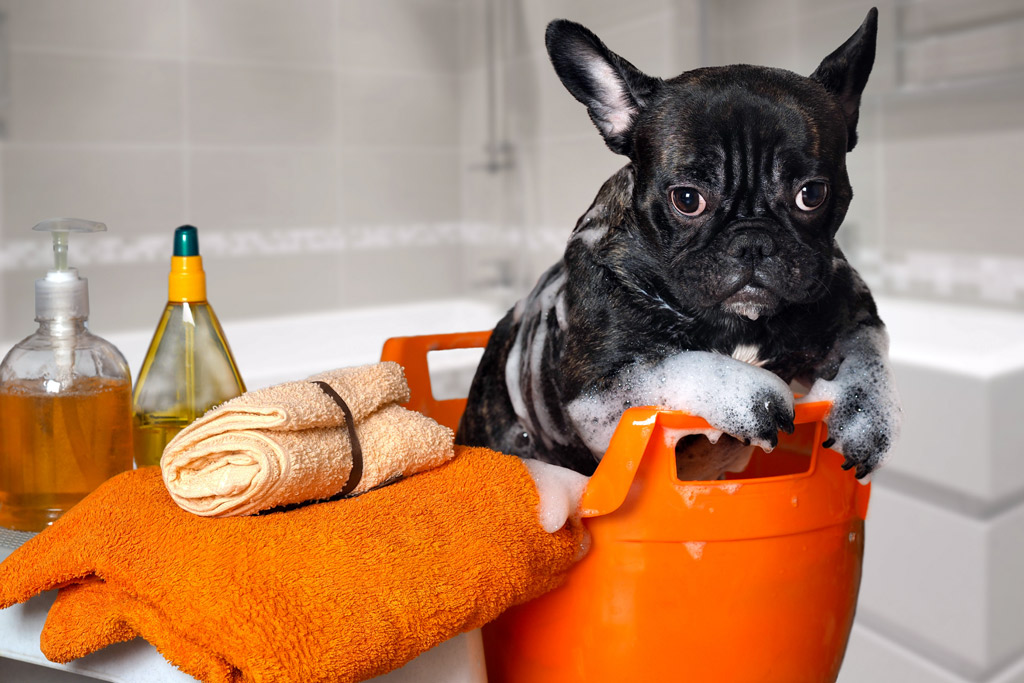
A Note on Dog Shampoos
Which Shampoo Should I Use?
You could combine various natural and organic ingredients to create your own dog shampoo and conditioner. But honestly, most people don’t have the time to do that.
So, my recommendation is to go for:
- Free of harsh chemicals (i.e. no sulfates and fragrance).
- Certified organic ingredients (like organic coconut oil).
What Ingredients to Avoid in Dog Shampoos?
Here are some tips on harmful ingredients to avoid:
- D-trans Allethrin: It is from a class of synthetic chemicals called pyrethroids, derived from natural chemicals found in chrysanthemums. Synthetic varieties are significantly more potent and persistent than naturally-occurring products and can cause allergic responses. Also a suspected endocrine system disruptor.
- Resmethrin: It is also from the chemical class called pyrethroids.
- Pyriproxyfen and S-Methoprene: It is considered relatively safe with low toxicity. However, data is lacking about their risks when combined with the above chemicals, which may be the case on some dog shampoo.
Also, you should avoid shampoos that include oatmeal since some animals have problems with grains and they are also likely to have problems with oatmeal shampoos.
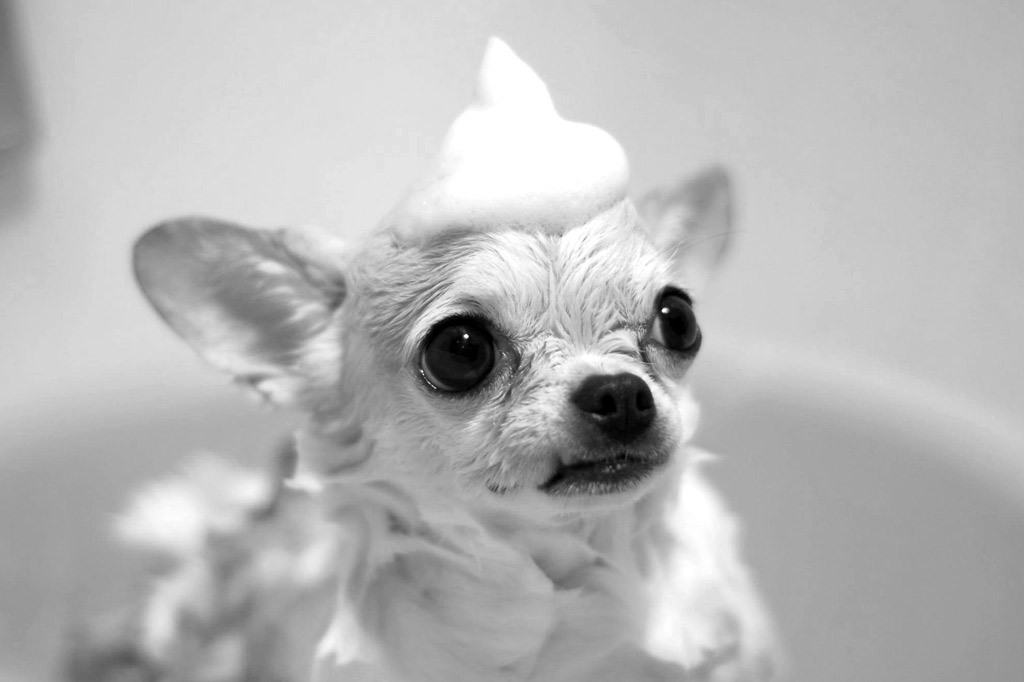
What Oils Can I Use for My Dog?
Here’s a list of natural oils to choose from:
- Organic Coconut Oil: Great for skin rejuvenation. It helps to exfoliate dead skin cells.
- Organic Sesame Seed Oil: Rich in vitamin E, B complex, and the minerals calcium, magnesium, and phosphorus. It’s is also an excellent moisturizer.
- Organic Jojoba Seed Oil: Technically, it’s not an oil, but a pure and luxurious liquid wax ester used to improve the appearance of dogs’ skin. It’s appropriate for sensitive skin. It contains vitamins E and B-complex, plus chromium, copper, zinc, and iodine.
- Organic Aloe Vera: Contains more than 130 compounds and 34 amino acids. It provides calcium, sodium, iron, potassium, chromium, magnesium, manganese, copper, and zinc… plus vitamins A, B1, B2, B6, B12, C, E, folic acid, and niacin.
- Organic Shea Butter: An all-natural vitamin A cream from West Central Africa, grown in the wild without pesticides. It is highly regarded as a superior, skin moisturizer, that revitalizes and softens skin and hair. It is also known to eliminate odours.
- Organic Olive Oil: It’s been long considered to be a “beauty oil”. It softens and moisturizes skin and hair. It also adds shine to hair.
Finally, I would like to emphasize the importance of a species-appropriate diet, this is true for humans and pets. A balanced diet provides the nutrients that your dog’s need and cannot help but impact the quality of her skin and hair.
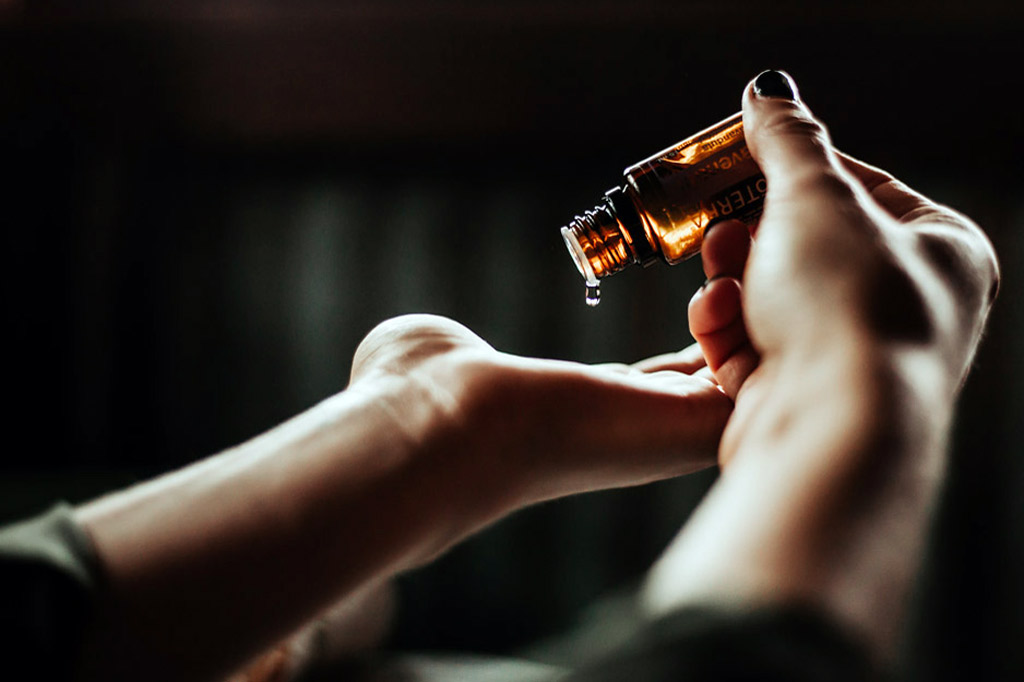
Grooming Routine
Brushing Your Dog’s Coat
Brush Regularly
In the beginning, try brushing your dog a few times a week for a few minutes at a time to create a routine. Once your dog is used to it, you should brush her every couple of days no matter the length of her coat.
Just a few minutes of brushing helps remove dirt, excess hair, tangles and mats while distributing oils that help keep the skin and coat healthy. Some dogs need more brushing than others, especially those with long hair and double-coated dogs that shed their undercoats seasonally.
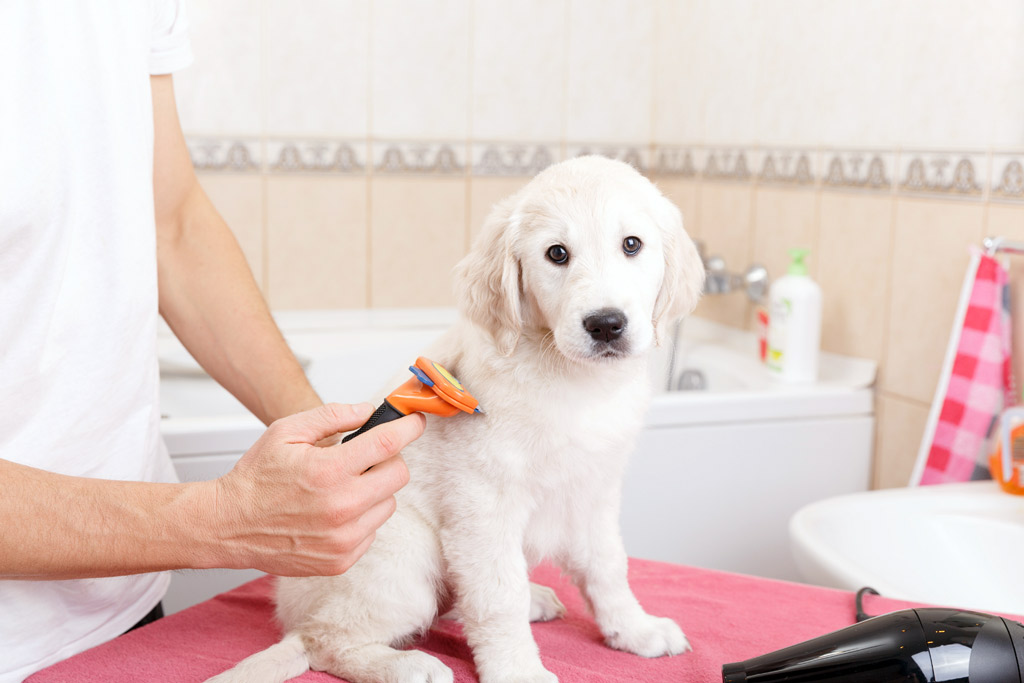
Stay Ahead of Matted Hair
Brushing not only keeps their coat healthy but also helps to remove hair mats. Matted hair can pull at the skin, causing pain and irritation. It also provides less insulation, making it harder for your dog to stay warm in the colder months.
Mats can occur more often in senior dogs who can no longer stretch to groom hard-to-reach places.
When removing mats, avoid using scissors because you can accidentally cut your dog’s skin. For small mats, you can use a metal comb to remove the mat, just start on the outside of the mat and gently pick it apart, working your way to the centre. For larger mats, you might want to take your dog to the groomer.
A Brush Type for Each Coat Type
Every breed has a type of coat and you should use a brush according to your dog’s hair type.
| Coat Type | Brush Type |
| Very short hair (Boston Terriers, Great Danes) | Rubber Brush* |
| Short and shedding hair (Labradors, Pugs) | Rubber Brush* |
| Short, thick and shedding hair (Huskies, German Shepherds) | Slicker Brush* |
| Medium Hair (Golden Retriever, Border Collies) | Slicker Brush* |
| Straight hair (Maltese, Yorkie) | Pin Brush* |
| Curly hair (Poodle, Bichon) | Metal Comb* |
*Note: the links above will take you to Amazon.
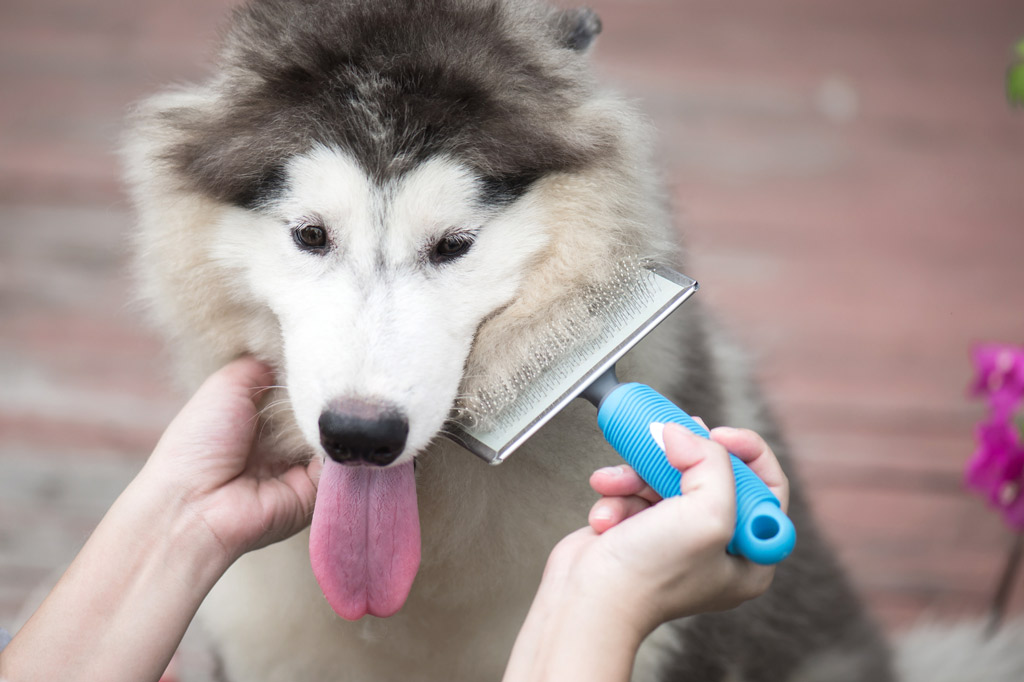
Cleaning Your Dog’s Ears
You should clean out your dog’s ears at least once a month and check them frequently. You can use sterile cotton or apply ear cleaner (made for dogs) with a cotton ball to clean them.
It’s natural to see a little bit of brown wax on the cotton ball after swiping the inside of your dog’s ear. But if the cotton ball comes out messy or stinky, your dog might have an ear infection and you should check with your vet.
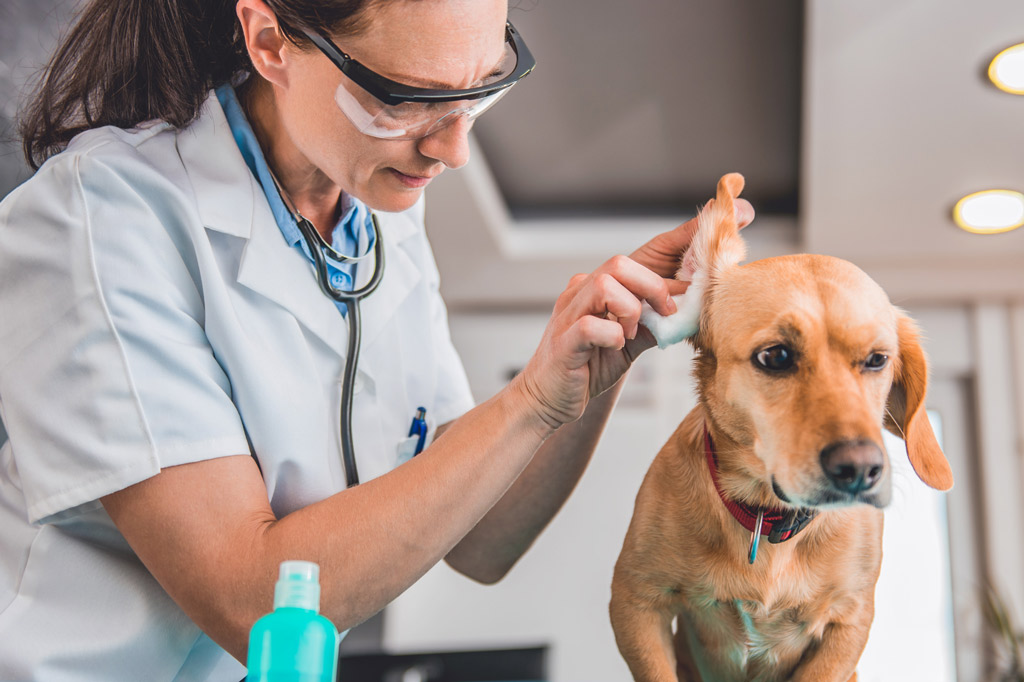
Cleaning Your Dog’s Eyes
At least once a week, you should take the time to look at your dog’s eyes and clean any specks of dirt around them.
Sometimes you can come across reddish-brown goop that can accumulate from normal tears; this is completely natural. However, if the discharge coming from her eyes is any different, you should check with your vet.
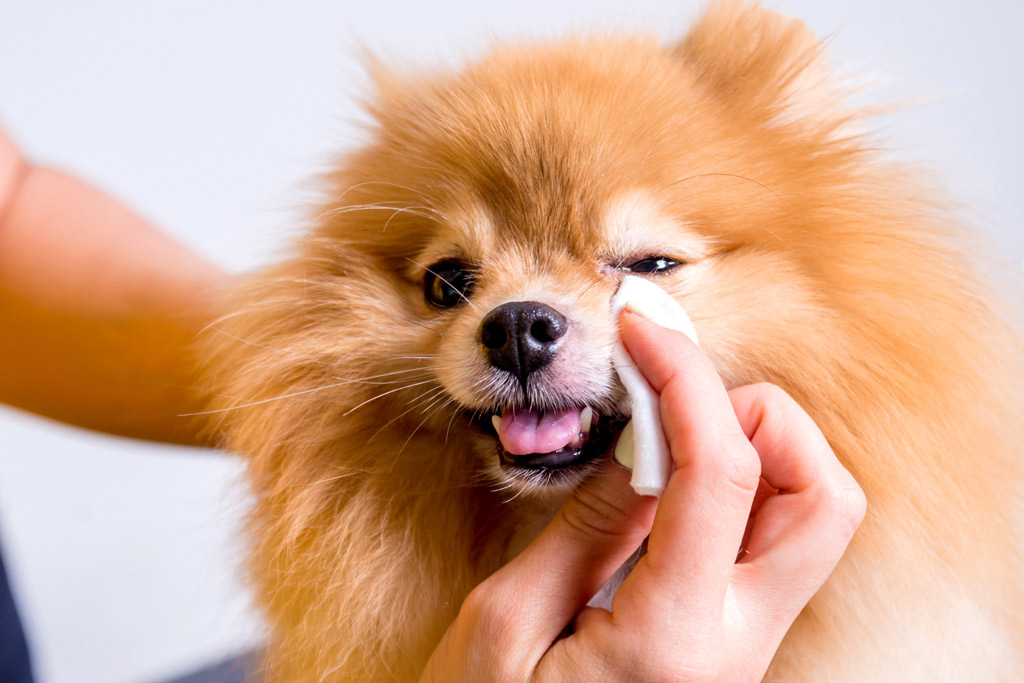
Cleaning Your Dog’s Paws
You may not realize it, but your dog’s paws pick up all kinds of allergens, chemicals and other pollutants, and it builds up quickly. This is because dogs are naked. They don’t wear clothes or shoes to avoid their bodies to collect a lot of allergens and chemicals in the environment.
All these harmful pollutants can become extremely irritating to their paws. That’s why removing these from your dog’s feet on a regular basis is very important.
“Believe it or not, a washcloth isn’t nearly as efficient at cleaning your dog’s feet as dunking them is. So when I say foot ‘soaks’ or ‘rinses,’ I mean exactly that.”
Dr Karen Becker, an integrative veterinarian.
Moreover, Dr Becker assures that you can reduce the amount of time your dog spends licking and chewing at her feet by 50% with a fast, easy foot soak.
However, where you soak your dog’s feet isn’t important – it’s how you do it, and how often, that makes the difference. A soak at the end of the day will reduce the chemical burden on your dog, as well as the potential for irritation.
The paw bath, step by step:
Step #1
You can use a bucket for big dogs, the bath or the kitchen sink for small ones.
Step #2
You need enough water to cover the pads of your dog’s feet. Then add povidone-iodine, which is an organic iodine solution. It’s safe, non-toxic, antifungal, antibacterial, and anti-yeast.
Step #3
If your dog is nervous, having treats nearby is very handy. Also, if she is scared of the water, rather than plunk her in the bath or sink, you can do a little mini-soak in a bucket. Have the mixture ready and soak one paw at the time!
Step #4
After you have soaked each foot for 2 to 5 minutes, there’s no need to rinse the solution off your dog’s feet. Just lift your dog out of the bath or remove that last foot and pat the paws dry.
Note that you can re-use the solution, but it’s not recommendable to go more than 2 or 3 days using the same foot soak solution.
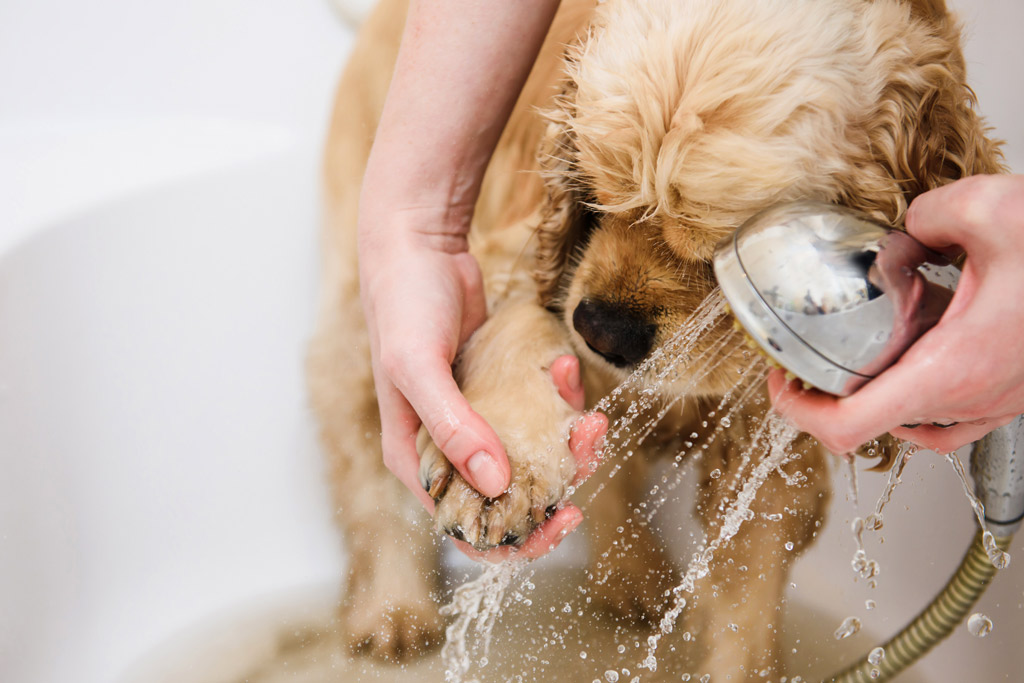
Bathing Your Dog
“How to bathe a puppy” and “How often should I bathe my dog” are frequent questions among dog owners. That’s why we created a step to step guide to answer this question. This grooming at home ritual also applies to young and older dogs.
Before going any further, it’s important to know when you can actually bath your dog.
Insider Tip: As a rule of thumb, dogs should only be bathed when they are dirty or stinky since they need the natural oils in their fur to keep their coats and skin healthy, and frequent bathing strips these oils out of their skin.
How Should I Bathe My Puppy?
In general, puppies don’t need to have a bath unless they’re visibly dirty or smelly. Most dog shampoos are for dogs around 3 months old or older, so you might want to go for a shampoo-less bath in the beginning. You can also check with your chosen vet if you want to bath your puppy before she’s 3 months old.
Putting a puppy in some warm, shallow water for a shampoo-less bath can be beneficial to both her and you. She’ll be needing at least occasional baths throughout her life, and bath time will be a lot easier if she enjoys it, or at least is accustomed to it.
When you wash very young puppies, keep them warm during cleaning and afterwards, as chilling can lead to illness or death.
For newborns, you can wash them gently with a warm, moist washcloth, particularly rubbing gently the lower abdomen and rectum areas. However, they don’t usually get “dirty,” as they’re not moving around or playing. Generally, since they are still with their mother dog, she will lick her puppies to clean them.
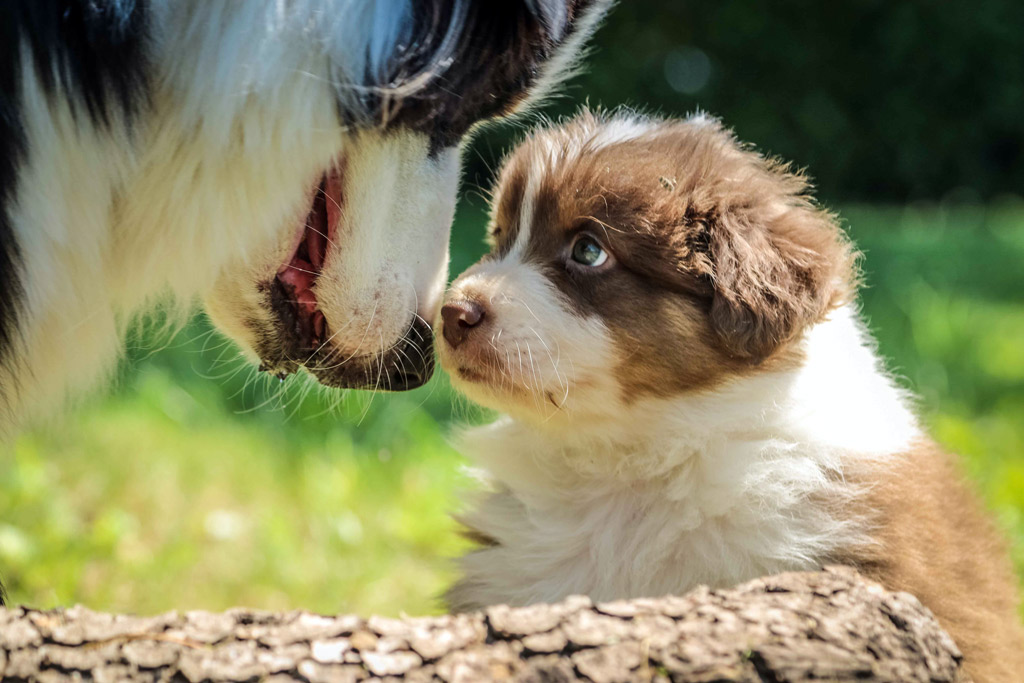
How Often Should I Bathe My Dog?
The main question here is how frequent should you be bathing your furry friend. It is recommendable to bathe your dog whenever she is dirty or stinky.
On days when you don’t give a full bath, you can give her a quick foot bath, keeping her paws clean will make her more comfortable.
Now it’s time to just follow these simple steps and enjoy the bath!
The bathing ritual, step by step:
The goal is – besides getting your dog clean – to create a positive experience so your dog likes (or at least tolerates) being bathed.
It’s beneficial for both puppy and owner to start getting in contact with water from early stages, since she’ll be needing at least occasional baths throughout her life, and bath time will be a lot easier if she enjoys it, or at least is accustomed to it.
Watch our tutorial here:
Step #0
Before bathing your dog, always brush her first. Otherwise, putting your dog in a bucket will only make the water dirty and her even dirtier.
Step #1
Place cotton balls in her ears.
Step #2
Place her in the tub, and pour water over her, so she gets thoroughly wet, especially if she has a full or long coat. Don’t pour water over your dog’s head. She can develop secondary ear infections from moisture in her ear canal.
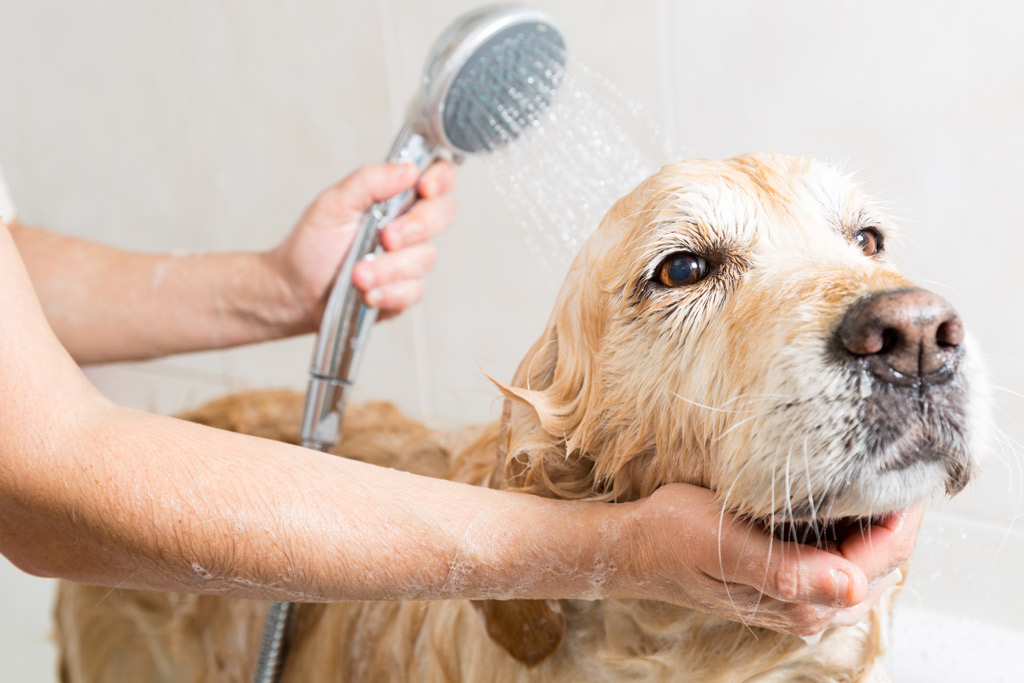
Step #3
Pour a strip of shampoo down your dog’s back. However, if your dog has dense hair, mix the shampoo with water before applying it for better distribution.
Step #4
Wash her armpits and under her neck. Go over the belly, groin, and all four legs and especially their paws (which pick up the most dirt).
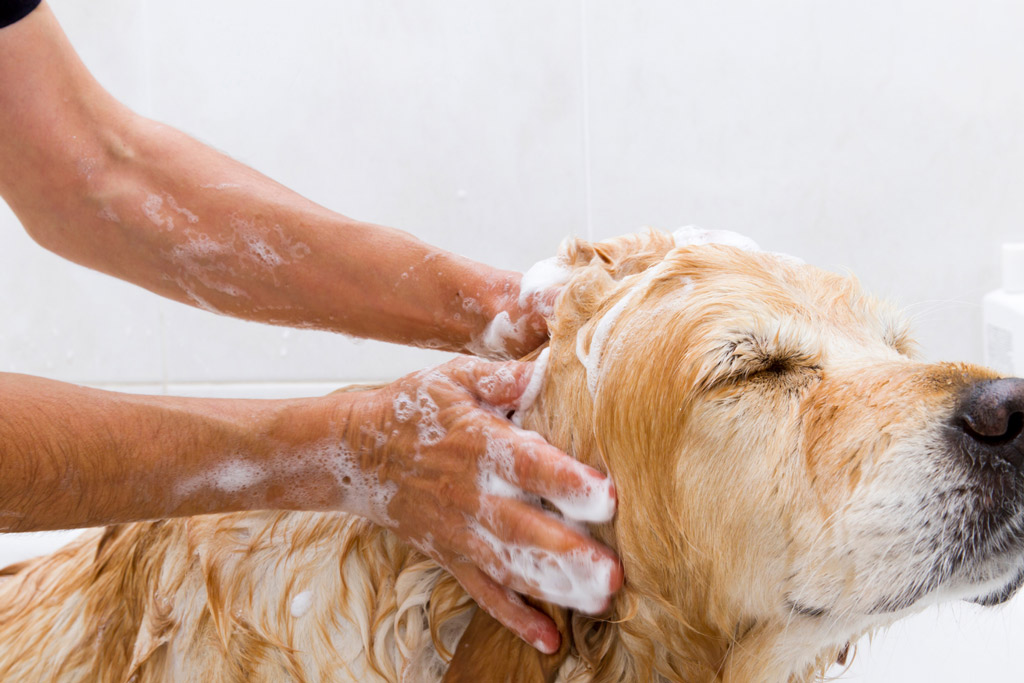
Step #5
Thoroughly rinse all the shampoo off your dog.
Step #6
Now take the washcloth and wipe her face.
Step #7
Wipe off the excess water with your hand, grab a towel, and pat her dry. Keep her warm, especially in the colder months.
Step #8
Remove the cotton balls from her ears, then check for dirt and debris. Swab them out with a cotton ball dampened with water or a special ear cleaner. Repeat until the cotton ball comes out clean.
Step #9
Finally, if she tolerates her bath well, you can blow dry on low heat. But don’t try this if she’s not content with her bathing process. Also, stop immediately if she becomes nervous or anxious.
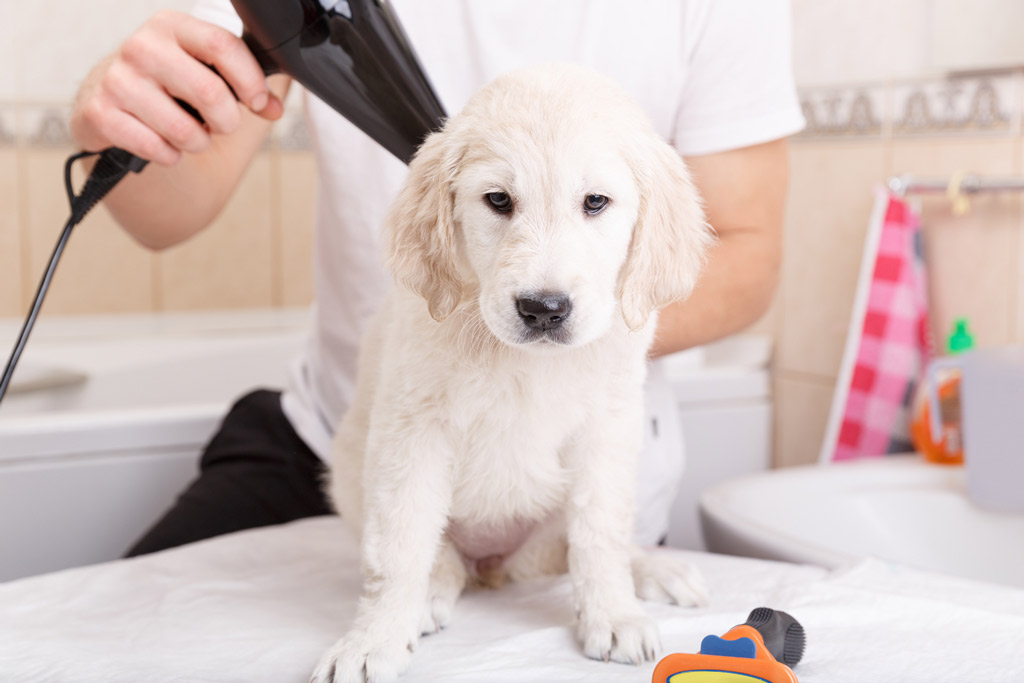
Insider Tip: You can make it a family activity, where everyone gets involved 🙂
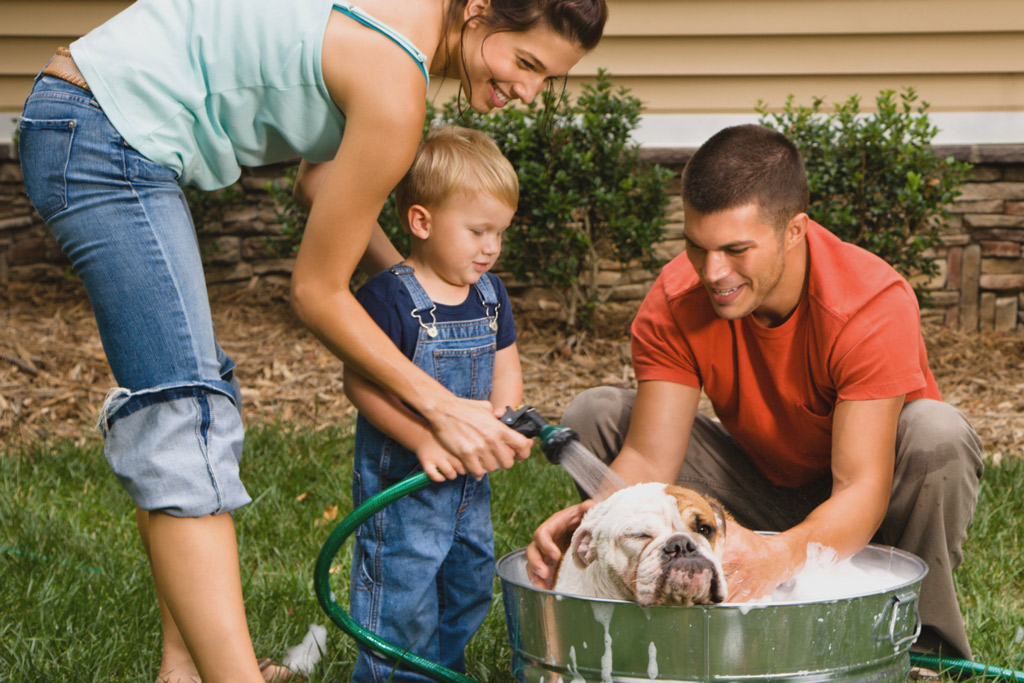
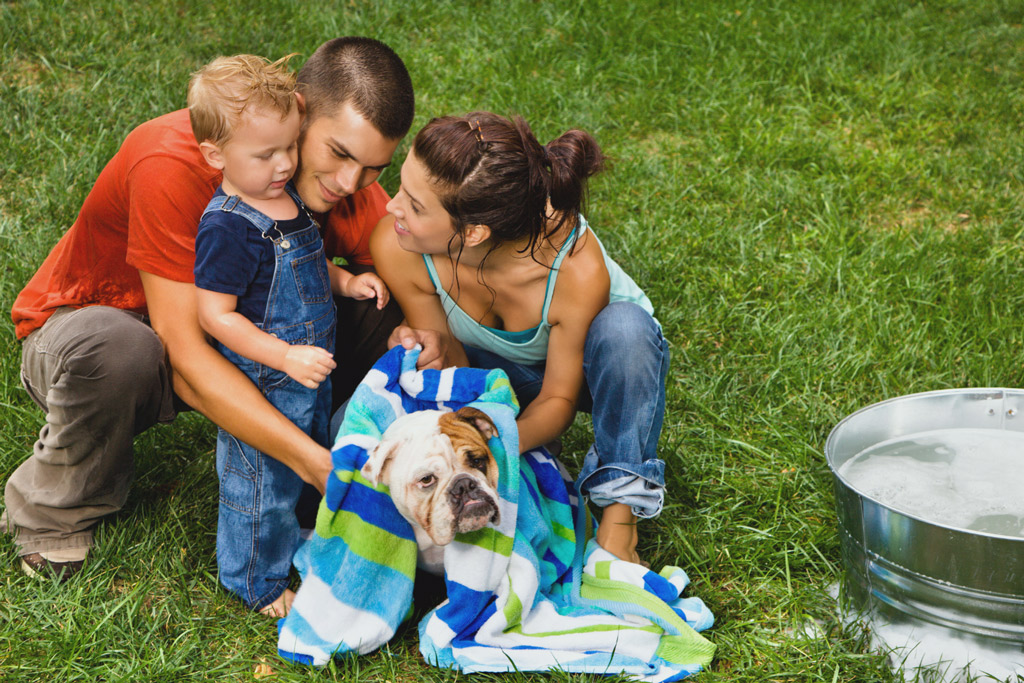
Trimming Your Dog’s Hair
Since trimming your dog’s hair comes with the risk of nicking your dog’s skin, only attempt to do it yourself once your dog is comfortable when her grooming routine and stays still.
Trimming Hair From Their Paws
Most dogs grow hair between their pads on the bottoms of their paws. The longer the hair gets, the more pesticides, sidewalk salt, and debris will collect. Also, longer hair can become matted and cause painful lumps to your pooch.
You can use scissors or trimmers to cut the hair in between your dog’s paw pads. Trim at the pads level and don’t dig down between the pads since it’s very easy to nick your dog’s skin.
Trimming Hair Around Their Eyes
Also, many dog breeds have hair that grows in the corner of their eyes. This needs to be trimmed regularly to prevent it from growing long enough to irritate your dog’s eyes.
You can trim it using:
- Round-tipped shears.
- Clippers with a no. 10 blade.
- Small electric trimmers.
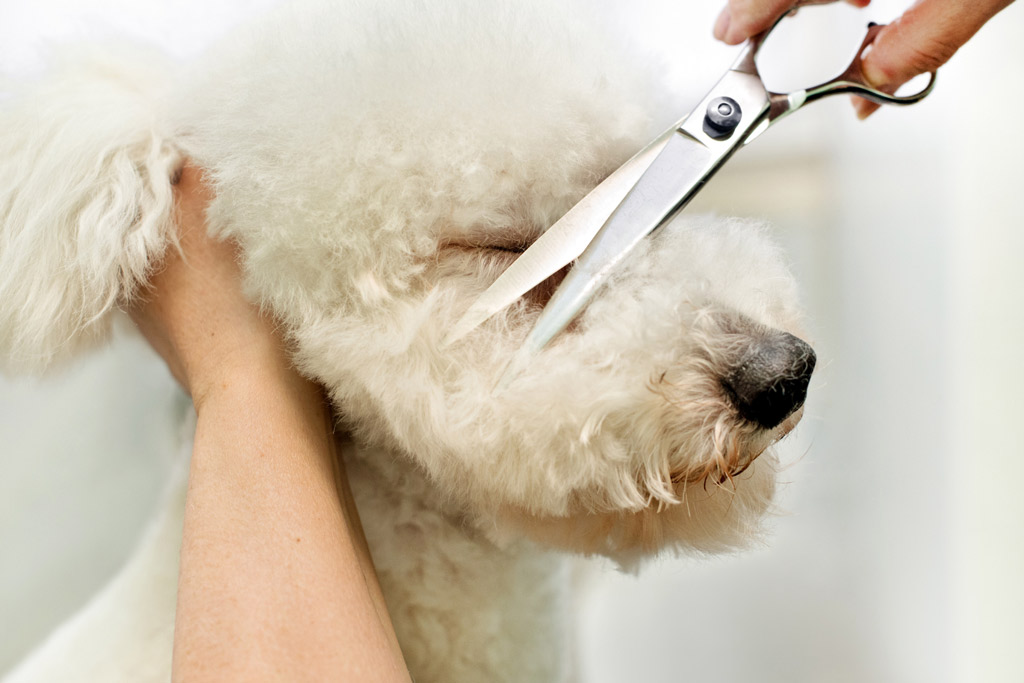
Clipping Your Dog’s Coat
Although you can clip your dog’s coat yourself, remember that a professional groomer has had months of training. If you still want to attend to clip your dog’s coat, I will suggest doing some research about how to groom your dog’s breed specifically.
Clipping a coat needs to be carried out in a careful manner to avoid skin injuries. Always make use of a sharp clipper for dogs and you a no. 10 blade to avoid cutting your dog’s skin.
However, during winter, avoid close clipping. Your dog is going to need the heat that her fur provides her during cold months.
Beware because clipper blades get very hot and you don’t want to burn your dog’s skin. Some people use blade coolant.
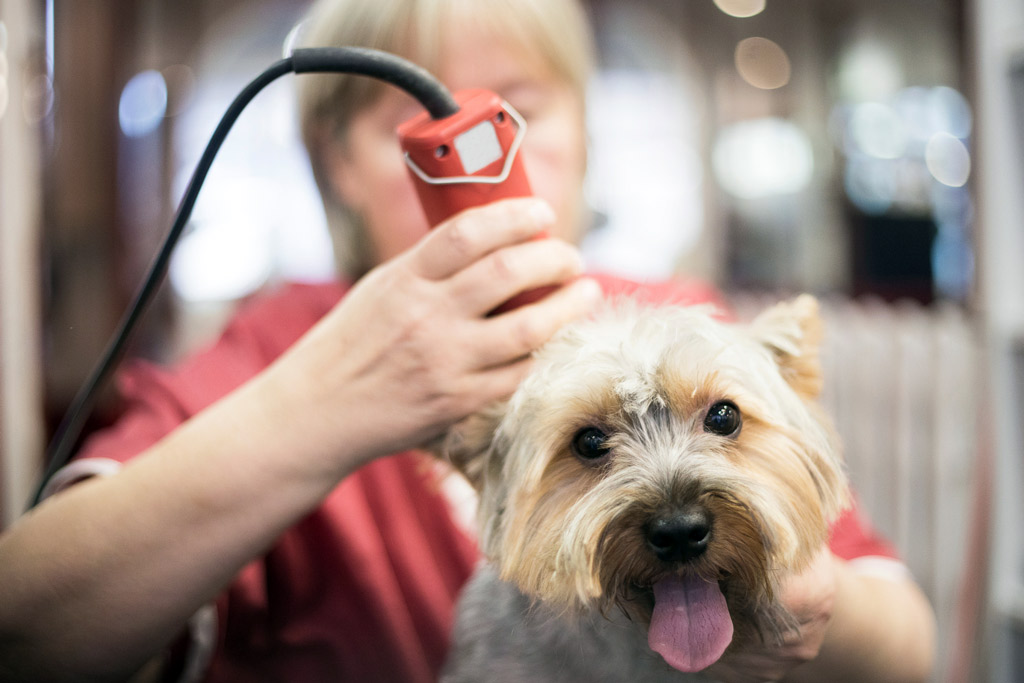
Trimming Your Dog’s Nails
Nail clipping can be stressful for your dog, so the first thing you should do is get her used to having her paws touched and handled – this should happen long before you try to trim her nails.
Therefore, treat rewards are a good way to distract a dog who is nervous or fearful about nail trims. Also, to reward her good behaviour after getting her nails clipped.
You can use a nail clipper or grinder (Amazon links) depending on what your dog can tolerate and your own preference. The nail clipper or trimmer is manual and the nail grinder is an electric rotary tool.
Also, you don’t have to get all the nails trimmed in one go. Trimming one nail a day is fine; you should do only as much as your dog is comfortable with.
In general, you should plan on trimming your dog’s nails once a month. Some dogs will need more- or less-frequent nail trimming. For example, large dogs that walk on sidewalks or asphalt need little trimming apart from their dew claws (their nails often wear down because of the longer walks). Small dogs, for instance, tend to go for shorter walks and need nail trimming every couple of weeks.
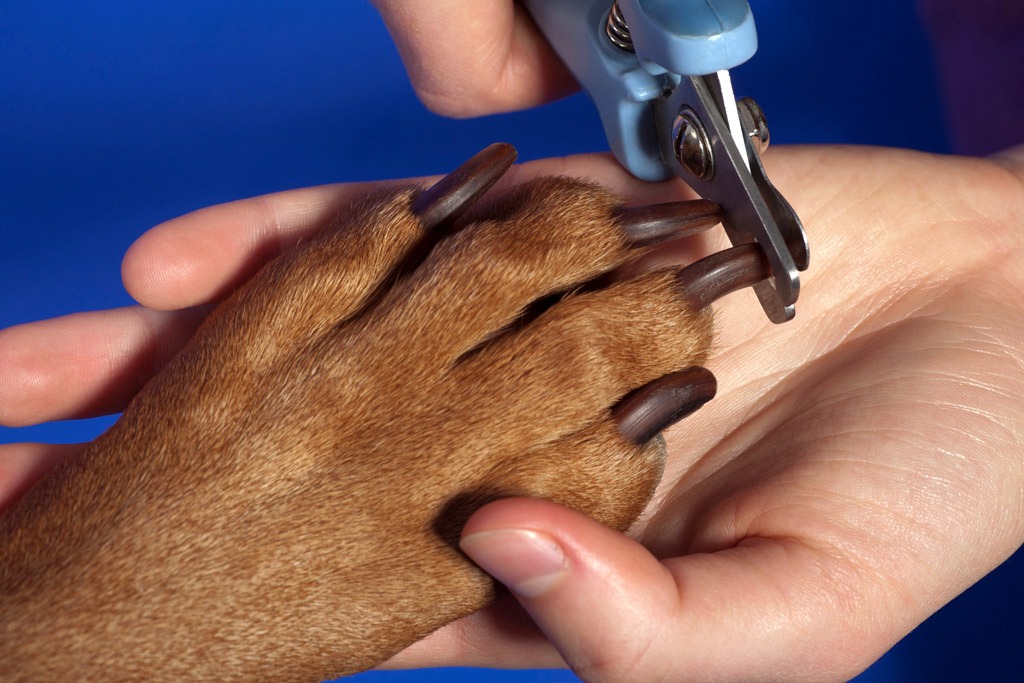
Nails must be trimmed very carefully to avoid cutting into the pinkish quick. The first rule of nail trims is to clip enough, but not too much. It can difficult to see the quick if your dog has dark nails.
Styptic powder is a must-have and should be at your fingertips before you start the nail trim, especially if this is your first time clipping them. Within your pet’s nails is something called the quick, which is a tiny blood vessel that is often clipped when inexperienced owners trim their pet’s nails.
Not only is this painful for your dog, but it will draw blood and can lead to infection if not properly treated. Styptic powder is both a clotting agent and an antiseptic that is used in situations like this.
Finally, if you want to reduce the amount of time your dog spends licking and chewing at her feet (removing all the dangerous bacteria) check the “Paw Bath” section above.
Watch our short nail trimming tutorial here:
Brushing Your Dog’s Teeth
A species-appropriate diet is crucial for your dog’s overall health, including their teeth. Raw bones, for example, are a great way to strengthen your dog’s gum in a natural manner.
However, regular at-home dental care is still needed for good dental health. Since they can’t do it themselves, it’s up to you to take responsibility and do it for them.
How fast your dog’s teeth get dirty depends on several factors:
- Your pet’s age and breed.
- Genetics.
- Your pet’s diet, as mentioned before (high-carbohydrate diets – or those containing rice, corn, wheat, tapioca, or potatoes – promote the need for more frequent dental cleaning).
- The amount of saliva your pet produces (the more the better).
Ironically, more often the smaller animals with smaller mouths need cleaning the most. Beware that the risk of dirty teeth dramatically increases for older dogs.
Furthermore, certain dog breeds are more prone to needing dental cleansing – Poodles, Maltese, Yorkshire Terriers, Chihuahuas, Shelties, Papillons, Pomeranians, and although far from small, Greyhounds.

How Can I Keep My Dog’s Mouth Clean?
- A species-appropriate diet, which includes raw meat.
- Encourage your dog to chew on raw bones (avoid cooked bones can splinter and cause serious internal injuries).
- Brush your dog’s teeth. Ideally, you want to brush your pup’s teeth every night, or at least several times a week.
Coconut oil is a wonderful option to keep your dog’s teeth and gums clean and free from the formation of plaque and bacteria. It is also great for their organism. You can apply it to their teeth with a brush, gently, or using your fingers. The sooner you get your dog use to this practice, the less weird it will feel for her.
In addition, commercial dog toothpaste and teeth brushes for dogs (Amazon links) are also available, you can check the ingredients for the most natural option.
Furthermore, specially prepared foods are available to remove the tartar and the plaque from your dog’s teeth. You can also find dry dog food and toys that are specially made to add strength to the teeth structures.
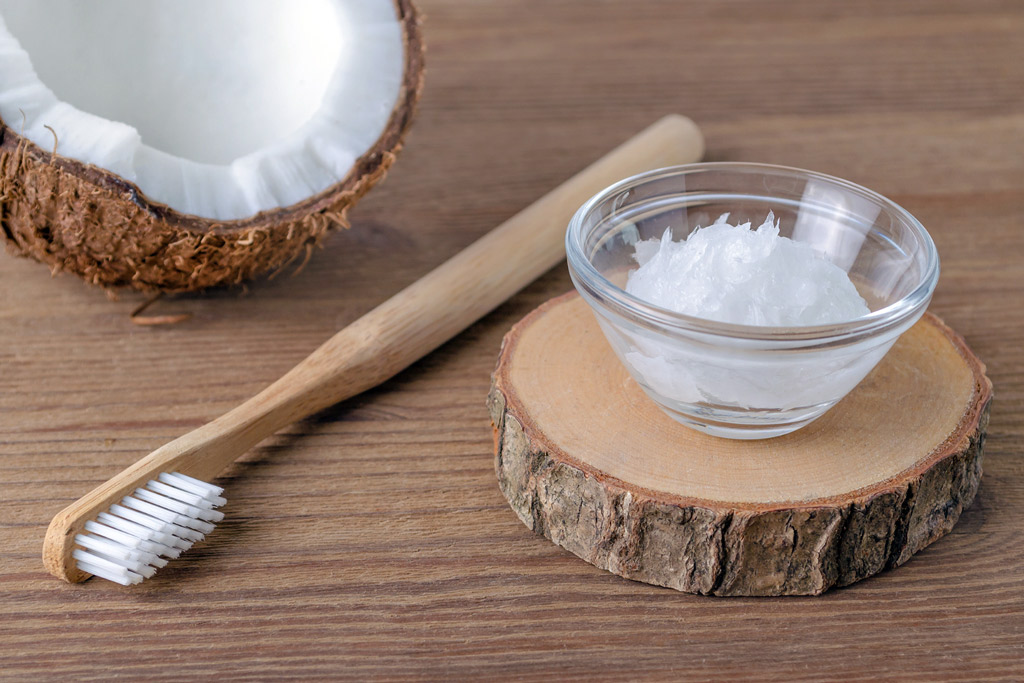
How Can I Brush My Dog’s Teeth?
The best time to establish a solid brushing routine, any grooming routine really is when your cat or dog is young, before the age of one.
Moreover, brushing your pet’s teeth doesn’t need to be an impossible task to accomplish. The key is to break the process down into steps and gradually work up to actual brushing!
Follow these simple steps to make brushing easier, plus less stressful for you both:
Brushing your dog’s teeth,
step by step:
Step #1
Firstly, spend at least a week getting your pet “ready” for brushing her teeth by massaging her lips with your finger in a circular motion once or twice a day.
Step #2
For the next week or so, move to her teeth and gums, massaging with your finger in a similar manner. Still no toothpaste or toothbrush yet.
Step #3
After she gets more comfortable, smudge a very small amount toothpaste or coconut oil on her lips. Spend at least a few days getting her accustomed to the taste.
Step #4
Now it’s time to introduce a piece of gauze and rub it against the teeth. Make small, circular motions on her teeth.
After your pet accepts that, you can move on to a “finger brush,” and finally to a pet toothbrush with soft bristles. But don’t rush the process, be patient with your furry friend.
Step #5
Then, add a small amount of toothpaste or coconut oil to the gauze or brush. Alternatively, use your finger.
Focus on the back teeth and the outsides of your pet’s teeth, as those tend to be dirtiest.
Step #6
After that, try working on a few teeth at a time. Gently massage your pet’s gums with the gauze or brush.
Finally, don’t forget the praise, always reward your pet’s good behaviour. It’s a great way for her to repeat positive actions. Since you want to avoid the scene on the photo below… 🙂
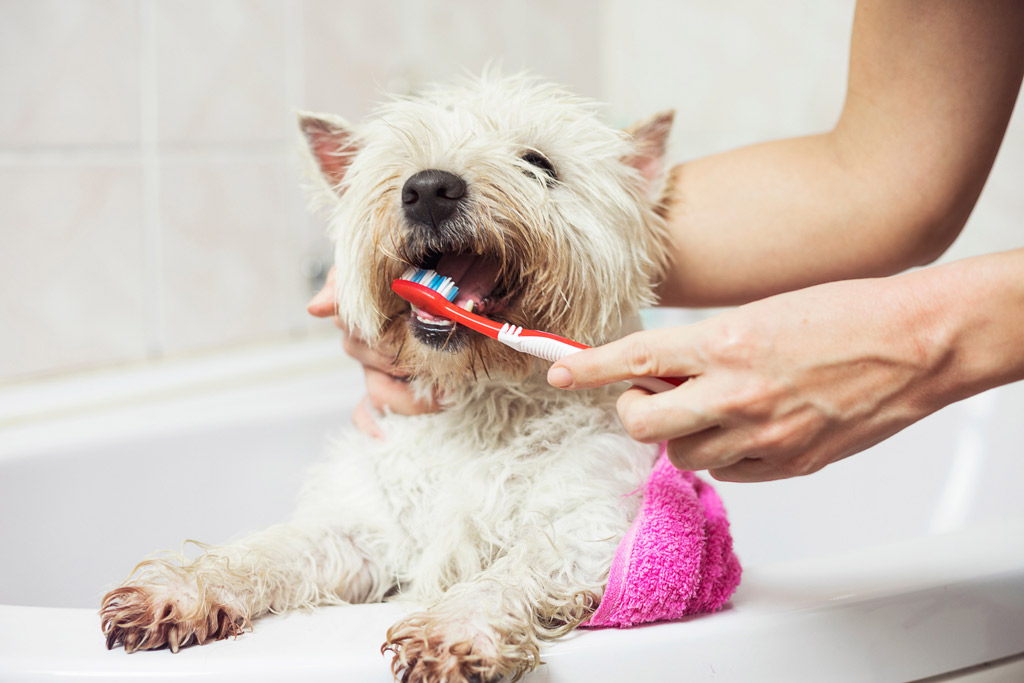
P.S. Grooming is an important factor for your pet’s overall health, like nutrition and health! For more pet care tips, check out our The 5 pillars to a happy and healthy dog blog post.
